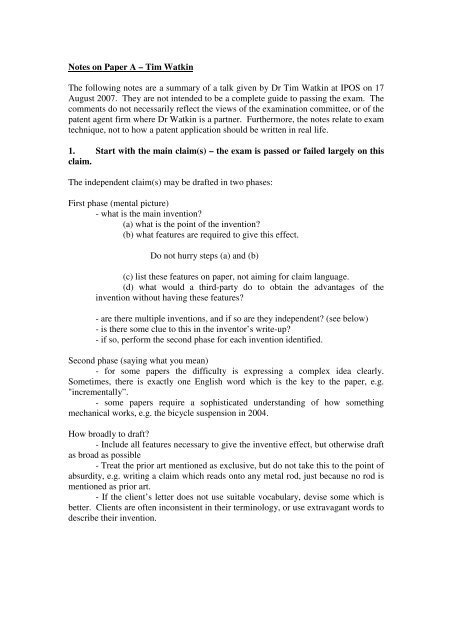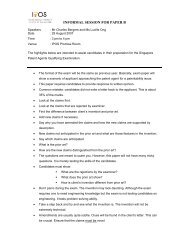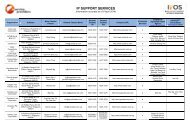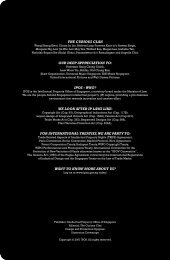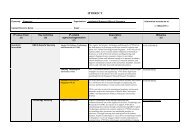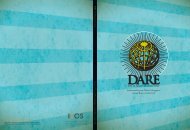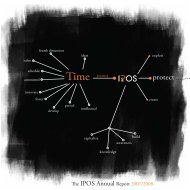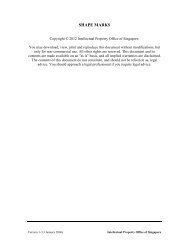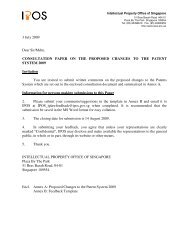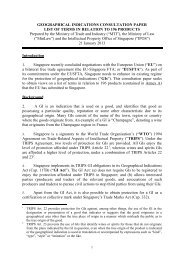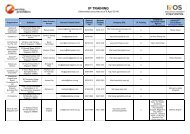Notes on Paper A â Tim Watkin The following notes are a summary ...
Notes on Paper A â Tim Watkin The following notes are a summary ...
Notes on Paper A â Tim Watkin The following notes are a summary ...
Create successful ePaper yourself
Turn your PDF publications into a flip-book with our unique Google optimized e-Paper software.
<str<strong>on</strong>g>Notes</str<strong>on</strong>g> <strong>on</strong> <strong>Paper</strong> A – <strong>Tim</strong> <strong>Watkin</strong><br />
<strong>The</strong> <strong>following</strong> <strong>notes</strong> <strong>are</strong> a <strong>summary</strong> of a talk given by Dr <strong>Tim</strong> <strong>Watkin</strong> at IPOS <strong>on</strong> 17<br />
August 2007. <strong>The</strong>y <strong>are</strong> not intended to be a complete guide to passing the exam. <strong>The</strong><br />
comments do not necessarily reflect the views of the examinati<strong>on</strong> committee, or of the<br />
patent agent firm where Dr <strong>Watkin</strong> is a partner. Furthermore, the <strong>notes</strong> relate to exam<br />
technique, not to how a patent applicati<strong>on</strong> should be written in real life.<br />
1. Start with the main claim(s) – the exam is passed or failed largely <strong>on</strong> this<br />
claim.<br />
<strong>The</strong> independent claim(s) may be drafted in two phases:<br />
First phase (mental picture)<br />
- what is the main inventi<strong>on</strong>?<br />
(a) what is the point of the inventi<strong>on</strong>?<br />
(b) what features <strong>are</strong> required to give this effect.<br />
Do not hurry steps (a) and (b)<br />
(c) list these features <strong>on</strong> paper, not aiming for claim language.<br />
(d) what would a third-party do to obtain the advantages of the<br />
inventi<strong>on</strong> without having these features?<br />
- <strong>are</strong> there multiple inventi<strong>on</strong>s, and if so <strong>are</strong> they independent? (see below)<br />
- is there some clue to this in the inventor’s write-up?<br />
- if so, perform the sec<strong>on</strong>d phase for each inventi<strong>on</strong> identified.<br />
Sec<strong>on</strong>d phase (saying what you mean)<br />
- for some papers the difficulty is expressing a complex idea clearly.<br />
Sometimes, there is exactly <strong>on</strong>e English word which is the key to the paper, e.g.<br />
"incrementally”.<br />
- some papers require a sophisticated understanding of how something<br />
mechanical works, e.g. the bicycle suspensi<strong>on</strong> in 2004.<br />
How broadly to draft?<br />
- Include all features necessary to give the inventive effect, but otherwise draft<br />
as broad as possible<br />
- Treat the prior art menti<strong>on</strong>ed as exclusive, but do not take this to the point of<br />
absurdity, e.g. writing a claim which reads <strong>on</strong>to any metal rod, just because no rod is<br />
menti<strong>on</strong>ed as prior art.<br />
- If the client’s letter does not use suitable vocabulary, devise some which is<br />
better. Clients <strong>are</strong> often inc<strong>on</strong>sistent in their terminology, or use extravagant words to<br />
describe their inventi<strong>on</strong>.
Give the field of the inventi<strong>on</strong> in the claim pre-amble. This eliminates a great deal of<br />
irrelevant prior art. For example, suppose the inventi<strong>on</strong> is a bicycle clip as shown:<br />
One possible claim might read:<br />
- Apparatus comprising a resilient el<strong>on</strong>gate element having two ends urged<br />
towards a predetermined mutual spacing by resilience of the middle secti<strong>on</strong>.<br />
However, this wording covers:<br />
or even<br />
Instead say, for example,<br />
- An trouser-leg clip for holding a trouser leg of a cyclist in a folded<br />
c<strong>on</strong>figurati<strong>on</strong> during cycling, the clip having…<br />
Check your claim.<br />
- Put yourself in the positi<strong>on</strong> of some<strong>on</strong>e who didn’t know the inventi<strong>on</strong>, and<br />
draw a picture of it from the claim. Do the advantages to be achieved flow from the<br />
features named?<br />
- How would you work around it?<br />
- Does it cover something obvious (even if not specifically menti<strong>on</strong>ed in the<br />
prior art)?<br />
- Can the claims be avoided by selling subordinate integers (e.g. a plug and<br />
socket) separately? What is the commercial product? Who will the infringers be?<br />
- How would you criticize the claim if some<strong>on</strong>e else had written it?
- Do the claims cover the c<strong>on</strong>structi<strong>on</strong> when empty, idle, placed <strong>on</strong> its side,<br />
upside down, etc?<br />
- Can the claim be made less pompous and more succinct?<br />
Dangerous limitati<strong>on</strong>s:<br />
- claiming by result “A bed which can be folded in half”.<br />
- but functi<strong>on</strong>al limitati<strong>on</strong>s <strong>are</strong> fine<br />
- “A bed having <strong>on</strong>e or more blankets, each blanket formed of a<br />
water-resistant material”.<br />
- "A bed having:<br />
a frame;<br />
a soft surface supported <strong>on</strong> the frame; and<br />
means for supporting the frame above a floor.<br />
- negative claiming: “A bed which does not have a mattress”.<br />
- number claims: “An alloy of tin comprising at least 10% copper”.<br />
“A chair with four legs”.<br />
- grammatical problems and ambiguities.<br />
- “A bed having a mattress and pillows which <strong>are</strong> soft”.<br />
- “A bed which has a mattress, having a soft surface”.<br />
- “A bed having a mattress and pillows, the pillows <strong>are</strong> soft and<br />
the mattress is hard”.<br />
2. Method claim?<br />
For some inventi<strong>on</strong>s a method claim is critical, and even the <strong>on</strong>ly way to claim<br />
something. For others, the <strong>on</strong>ly possible use of an inventive product is private and<br />
n<strong>on</strong>-commercial, so a method claim is useless, and there <strong>are</strong> likely to be no marks <strong>on</strong><br />
the marking schedule for it. To decide whether to include a method claim, c<strong>on</strong>sider<br />
what the infringer is going to do? A method claim will <strong>on</strong>ly be of use if the infringer<br />
the client needs protecti<strong>on</strong> against is going to carry out the steps of the method.<br />
3. Unity<br />
If there <strong>are</strong> more than two main independent ideas, then you must draft an<br />
independent claim for each of them. Note that in most years this is not required.<br />
When it is not required, it actually loses marks.<br />
Multiple independent claims (especially in the same category, e.g. both<br />
apparatus claims) may mean that the patent lacks unity. This is acceptable when it is<br />
necessary to give the client adequate protecti<strong>on</strong>, but you must make a note to say that<br />
you realise there is a lack of unity, and what opti<strong>on</strong>s exist to solve the problem, e.g.<br />
file divisi<strong>on</strong>al applicati<strong>on</strong>s later, or file multiple applicati<strong>on</strong>s immediately.<br />
Sometimes, when this situati<strong>on</strong> applies, the instructi<strong>on</strong>s to candidates give you hints<br />
as to what the examiners <strong>are</strong> expecting, e.g. that a full claim-set should be provided<br />
for <strong>on</strong>ly <strong>on</strong>e of the c<strong>on</strong>cepts, and that any other major claim should be either just<br />
sketched out, or <strong>on</strong>ly a main claim is required, not sub-claims.
Note that including multiple independent claims is not a way of hedging your bets<br />
about the required scope of the main claim! As menti<strong>on</strong>ed above, when there is no<br />
good reas<strong>on</strong> for multiple independent claims, they <strong>are</strong> penalized.<br />
4. Sub-claims<br />
Marks <strong>are</strong> probably <strong>on</strong>ly available <strong>on</strong> the marking schedule for sub-claims to features<br />
which <strong>are</strong> not in the prior art.<br />
Marks <strong>are</strong> <strong>on</strong>ly available for features which achieve some sort of advantage. A subclaim<br />
is worthless if it has no chance of being upheld when the independent claim is<br />
not. For example, “A floppy disk according to claim 1 in which the cover is plastic.”<br />
Keep the number of sub-claims low; less than 10 normally.<br />
5. Remainder of the patent applicati<strong>on</strong><br />
<strong>The</strong>re may be some marks for the descripti<strong>on</strong> of the prior art.<br />
Objects/ advantages should be very included but kept very general. For example, the<br />
sentence “<strong>The</strong> object is to obtain 100% efficiency” is dangerous. Better <strong>are</strong>: “<strong>The</strong><br />
object is to improve the efficiency” and “Certain c<strong>on</strong>structi<strong>on</strong>s may achieve an<br />
efficiency approaching 100%”.<br />
<strong>The</strong> <strong>summary</strong> secti<strong>on</strong> should include paragraphs which mirror corresp<strong>on</strong>ding claims,<br />
giving the advantage associated with each.<br />
<strong>The</strong>re should be no limiting statements about the inventi<strong>on</strong> which <strong>are</strong> narrower than<br />
the broadest claim.<br />
<strong>The</strong> descripti<strong>on</strong> of the drawings should be clear, have correct reference numerals, and<br />
refer to the "embodiment”, not the “inventi<strong>on</strong>”. It should almost always use the same<br />
language as the claims/<strong>summary</strong>, so that corresp<strong>on</strong>dence is clear. All features of the<br />
drawings should be described.<br />
Obviously, this should be based <strong>on</strong> the inventor’s descripti<strong>on</strong>, but re-write the<br />
inventor’s descripti<strong>on</strong> if there is anything wr<strong>on</strong>g with it.<br />
6. Practising for the exam<br />
- Do past papers, but have them checked by an experienced, technicallyqualified<br />
patent agent.<br />
- Do not do these past papers quickly. This is training you to do it badly!<br />
Useful book:<br />
“Fundamentals of patent drafting", by Paul Cole, CIPA (2006), incorporating two<br />
classic papers by Micklethwait and Daley.
7. <strong>Tim</strong>e management is crucial<br />
You have 240 minutes working time.<br />
Do not start writing until you have fully read the paper and understood it.


